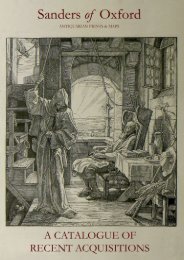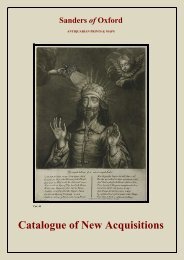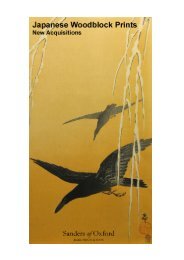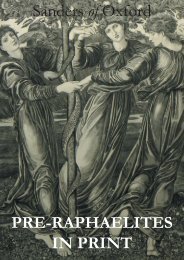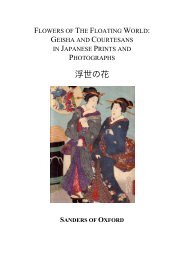Mezzotints & Engravings after J.M.W.Turner.pdf - Sanders of Oxford
Mezzotints & Engravings after J.M.W.Turner.pdf - Sanders of Oxford
Mezzotints & Engravings after J.M.W.Turner.pdf - Sanders of Oxford
Create successful ePaper yourself
Turn your PDF publications into a flip-book with our unique Google optimized e-Paper software.
Though much has been written on the painting <strong>of</strong> J.M.W <strong>Turner</strong>, the contribution <strong>of</strong> the artist towards<br />
prints <strong>after</strong> his work is rarely discussed. This is perhaps because they were executed, for the most part,<br />
by other engravers. Inquisitively minded, and experimental in his approach, it was all but inevitable that<br />
<strong>Turner</strong> should engage himself in the printmaking process.<br />
<strong>Turner</strong>’s involvement with prints began at a young age. As a ten year old, <strong>Turner</strong> was employed in<br />
hand-colouring engravings for Henry Boswell’s Picturesque Views <strong>of</strong> the Antiquities <strong>of</strong> England and<br />
Wales. Whilst at the Academy schools, it is known that he copied an etching ground recipe onto the<br />
verso <strong>of</strong> a study. A few years later, and at the age <strong>of</strong> eighteen, <strong>Turner</strong>’s work was first reproduced. The<br />
commissioned piece was a scene <strong>of</strong> Rochester. Engraved by John Walker and John Storer, the<br />
topographical view was published in the Copper-plate Magazine in 1794. <strong>Turner</strong> enlisted to paint<br />
Rochester again in 1823 (See catalogue no. 11). On this occasion, William Bernard Cooke published the<br />
work whilst Thomas Lupton was the man who replicated the spires <strong>of</strong> the cathedral and the swell <strong>of</strong> the<br />
Medway. Similar compositionally to the 1794 work, these two views <strong>of</strong> the Kentish town illustrate the<br />
scope <strong>of</strong> <strong>Turner</strong>’s prints. Whilst the earlier print is somewhat trite, Lupton’s edition displays<br />
comparatively rich and luminous modulations. Nearly thirty years elapse between the publication <strong>of</strong> the<br />
prints, and during this period <strong>Turner</strong>’s painterly style certainly matured. However, the growing<br />
instruction and supervision that <strong>Turner</strong> placed in his engravers is perhaps most accountable for this shift<br />
in quality. The marked inferiority <strong>of</strong> the renderings <strong>of</strong> <strong>Turner</strong>’s work by the same engravers, <strong>after</strong> the<br />
death <strong>of</strong> the artist, bears witness to this notion.<br />
In the first few decades <strong>of</strong> the nineteenth-century, <strong>Turner</strong> amassed a group <strong>of</strong> mezzotinters and lineengravers<br />
to whom he would repeatedly turn. The engravers, whilst able to display their distinct<br />
aesthetic personalities, were also attuned to the requirements <strong>of</strong> <strong>Turner</strong>. The artist’s wants were at times<br />
exacting. He would frequently annotate pro<strong>of</strong> impressions with a salvo <strong>of</strong> amendments, instructions,<br />
comments and diagrams. In fact, when working upon his Liber Studiorum (1806-1819), <strong>Turner</strong> is known<br />
to have etched preliminary designs into the plates himself. A touched pro<strong>of</strong> <strong>of</strong> More Park, near Watford,<br />
on the River Colne (Catalogue no. 3) at Yale University pays testament to <strong>Turner</strong>’s role as director. A<br />
keen overseer and master <strong>of</strong> technical details, <strong>Turner</strong> included a barrage <strong>of</strong> plaudits and revisions in a<br />
message to his namesake Charles. Be it for the gift book or the sketching tour, the artist learned how to<br />
select colours and tones in paint to provide the basis for transcription into black and white.<br />
The accomplished result <strong>of</strong> <strong>Turner</strong>’s prints was largely due to the artist’s management <strong>of</strong> the pro<strong>of</strong><br />
stage. Thus, it was not only his painterly skill and fame that created demand amongst publishers for his<br />
contributions, but also his ability to inspire and instruct engravers. This can be seen in his collaboration<br />
with Cooke for The Rivers <strong>of</strong> England, whereby <strong>Turner</strong> not only provided sixteen watercolours, but was<br />
paid an additional fee <strong>of</strong> two guineas for touching the pro<strong>of</strong>s <strong>of</strong> the plates <strong>after</strong> Thomas Girtin.<br />
<strong>Turner</strong>’s work provided a nomadic span <strong>of</strong> English, and <strong>after</strong> the war, European topography. The notion<br />
<strong>of</strong> departure, however, could also be seen in his fiscal deaings. The artist adopted a new system whereby<br />
he retained copyright as well as the original drawings, thus loaning watercolurs to publishers and<br />
recalling them <strong>after</strong> the engraving process. This act ensured that the publishers were prevented from<br />
selling the preliminary works at inflated prices or compromising the original prints with cheap<br />
reproductions. It is also interesting to note that none if his late paintings were engraved in his lifetime,<br />
although many people saw them at the Academy. It is as if he kept two artistic personae, ‘the illustrator’<br />
and ‘the experimenter’.<br />
This catalogue brings together an important selection <strong>of</strong> prints <strong>after</strong> <strong>Turner</strong>. From <strong>Oxford</strong> to<br />
Okehampton, it is a brief survey which includes the work <strong>of</strong> numerous engravers and publishers. A<br />
neglected area <strong>of</strong> his opus, this release acts as a testament to an artist seldom credited for the outstanding<br />
achievements <strong>of</strong> British engraving between the decades <strong>of</strong> 1820 and 1860.<br />
George Richards




